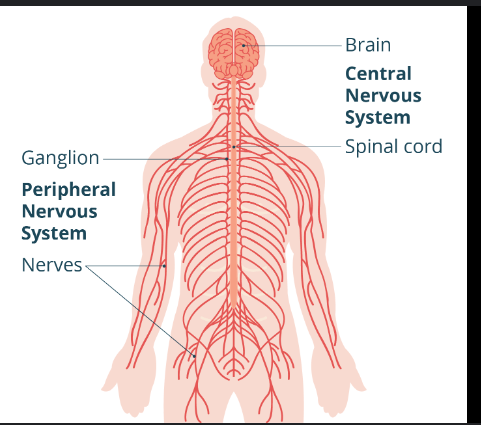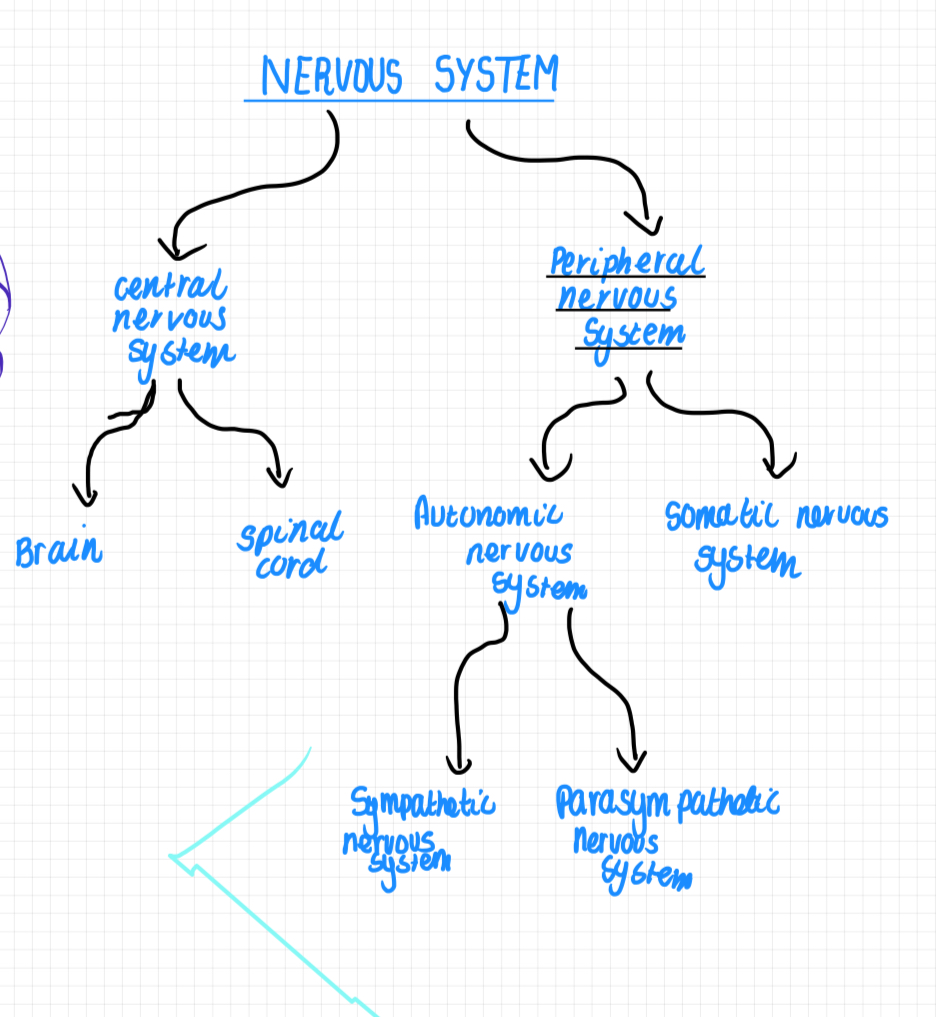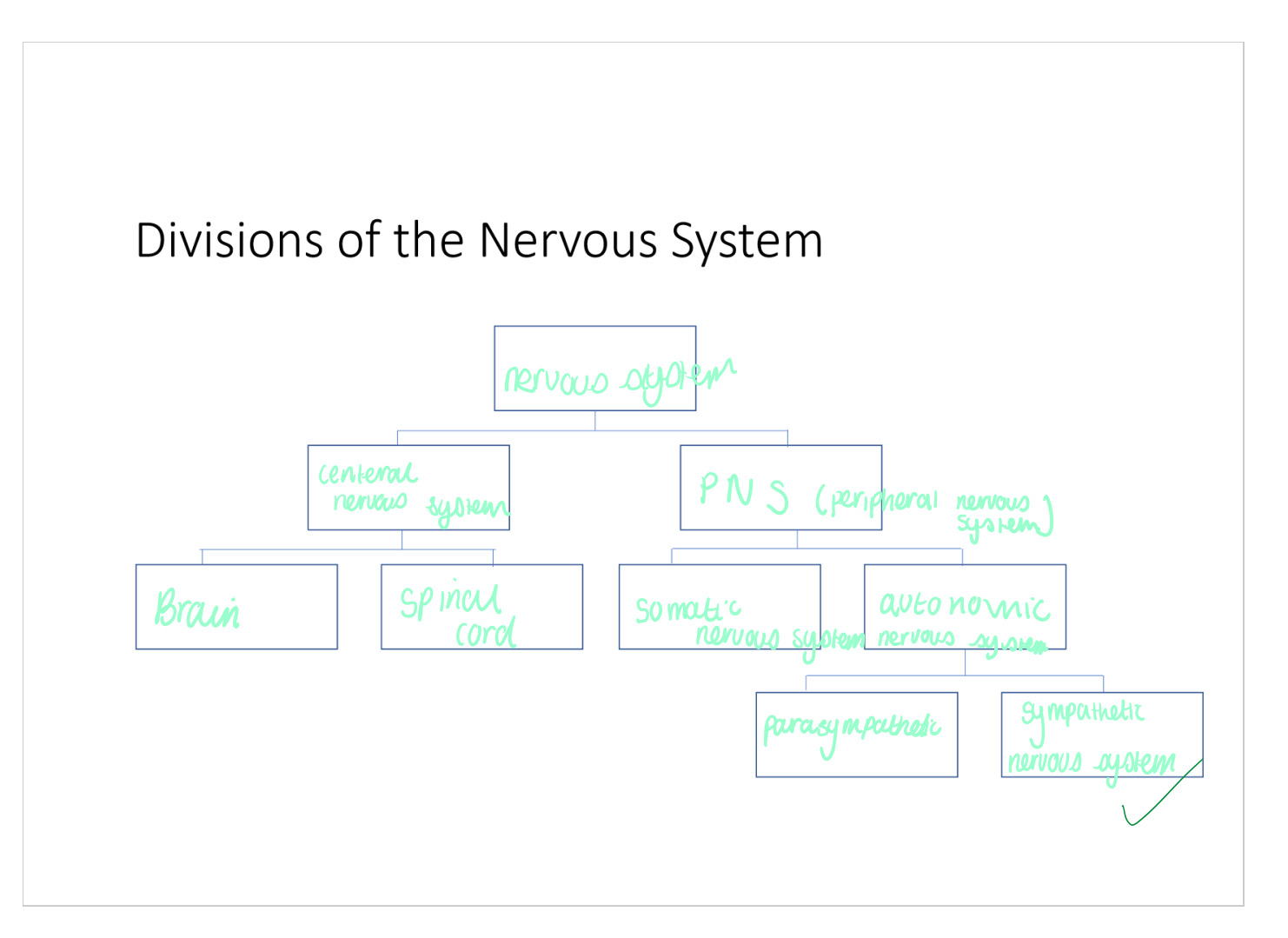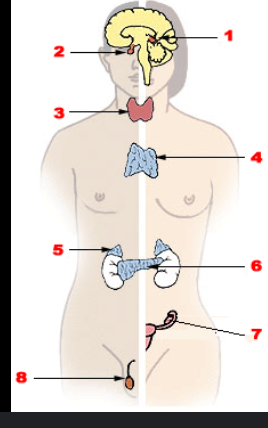The nervous & endocrine system - bio-psychology
1/26
Earn XP
Description and Tags
Name | Mastery | Learn | Test | Matching | Spaced |
|---|
No study sessions yet.
27 Terms

what is the nervous system
this consists of the central nervous system and the peripheral nervous system communicates using electrical signals
this is our primary internal comunnication singla
what are the division of the nervous system

what is the function of the nervous system ?
to collect, process and to respond to information in the environment
to co-ordinate the working of different organs and cells in the body
what are the two subsections the nervous system is divided into
the central nervous system
peripheral system
what is the CNS made up of ?
made up of the brain and spinal cord
what is the function of the brain ?
the brain is the centre of all conscious awareness
the brains outer layer the cerebral cortex = 3mm thick + covers brain like an orange peel -
highly developed in humans and is what distinguishes our higher mental functions from those of other mammals
what is the function of the spinal cord ?
it is an extension of the brain
it passes messages to and from the brain
connects nerves too the PNS
it is also responsible for reflex actions such as puling hand away from hot plate
describe the nervous system

what is the peripheral nervous system ?
sends information to the CNS from the outside world, and transmits messages from the CNS to muscles and glands in the body
they transmit messages via millions of neurons to and from the cns
it is further split into the autonomic and somatic nervous system
what is the somatic nervous system ?
transmits information from receptor cells in the sense organs to the CNS
it receives information from the CNS that directs muscle to act
governs muscle movement and receives info from sensory receptors -voluntary muscle movement occur
what is the autonomic nervous system ?
transmits info to and from internal bodily organs.
operate involuntary
has two main divisions the sympathetic and parasympathetic
controls:
breathing
hr
digestion
sexual arousal
stress response
what does the sympathetic system do
the branch concerned with expending energy - fight / flight response
what does the parasympathetic system do
concerned with conserving energy ( the natural resting state)
i.e. reduces hr
causes digestion to continue to take place
speed of nervous system compared to endocrine
the nervous system acts more rapidly than the endocrine system but they are both very fast
average response is 0.25s but can be as quick as 100 milliseconds
endocrine response is slower because hormones have to travel through the blood stream
what is the endocrine system ?
one of body’s major information systems that instructs glands to release hormones directly into the blood stream.
these hormones are carried towards target organs in the body communicates via chemicals
what does the endocrine system consist of ? and what does it do
it consists of glands that produce hormones which are released into the blood stream to be taken all over the body
hormones act slower than the nervous system but can take their messages over a much wider area

label the glands
1) hypothalamus
2) pituitary gland
3) thyroid
4)parathyroid
5) adrenal gland
6) pancreas
7) ovaries
8) testes
how do most hormones work use thyroid - throxine as a en example
most hormones affect cells in more than one body organ, leading to a diverse and powerful response
i.e. thyroid produces the hormone thyroxine - this effects cells in the heart and also increase the body’s metabolic rate in turn effecting growth rate
what is the pituitary gland
located in the brain
known as the master gland because it controls the releases of hormones from all the other endocrine glands in the body
explain how the autonomic system and endocrime system work together when
when stressors = perceived - hypothalamus activates the pituitary gland
this triggers activity in the sympathetic branch of the autonomic nervous system
the ANS changes from its normal resting state parasympathetic to the sympathetic state
adrenaline is then released from the adrenal medulla into the blood stream
this triggers physiological changes in the body(increased HR)-creates the necessary physical arousal for F&F
Once the threat is over the parasympathetic nervous system returns the body to resting state
what is the most important thing about the fight&flight response
that it all happens in an instant as soon as the threat is detected
an acute automatic reaction in the body
what are the main physiological changes associated with the sympathetic state
increased HR
increased breathing rate
dilates pupil
inhibits digestion
inhibits saliva production
contracts rectum
what are the physiological behaviours associated with the parasympathetic state
decreased HR
decreased breathing rate
contraction of pupils
stimulates digestion
stimulates saliva production
relaxes rectum
what is adrenaline
a hormone produced by the adrenal glands which is part of the human body’s immediate stress response system
what physiological changes are associated with adrenaline
contracting blood vessels
dilating air passages
stimulating heart rate
huge effects on the cells in the cardio vascular systems
what is the fight /7 flight response
the way animals respond when stressed
the body becomes physiologically aroused in readiness to fight an aggressor or flee
what is the endocrine system ?
one of the body’s major information systems that instructs glands to release hormones directly into the blood stream
hormones are carried towards target organs